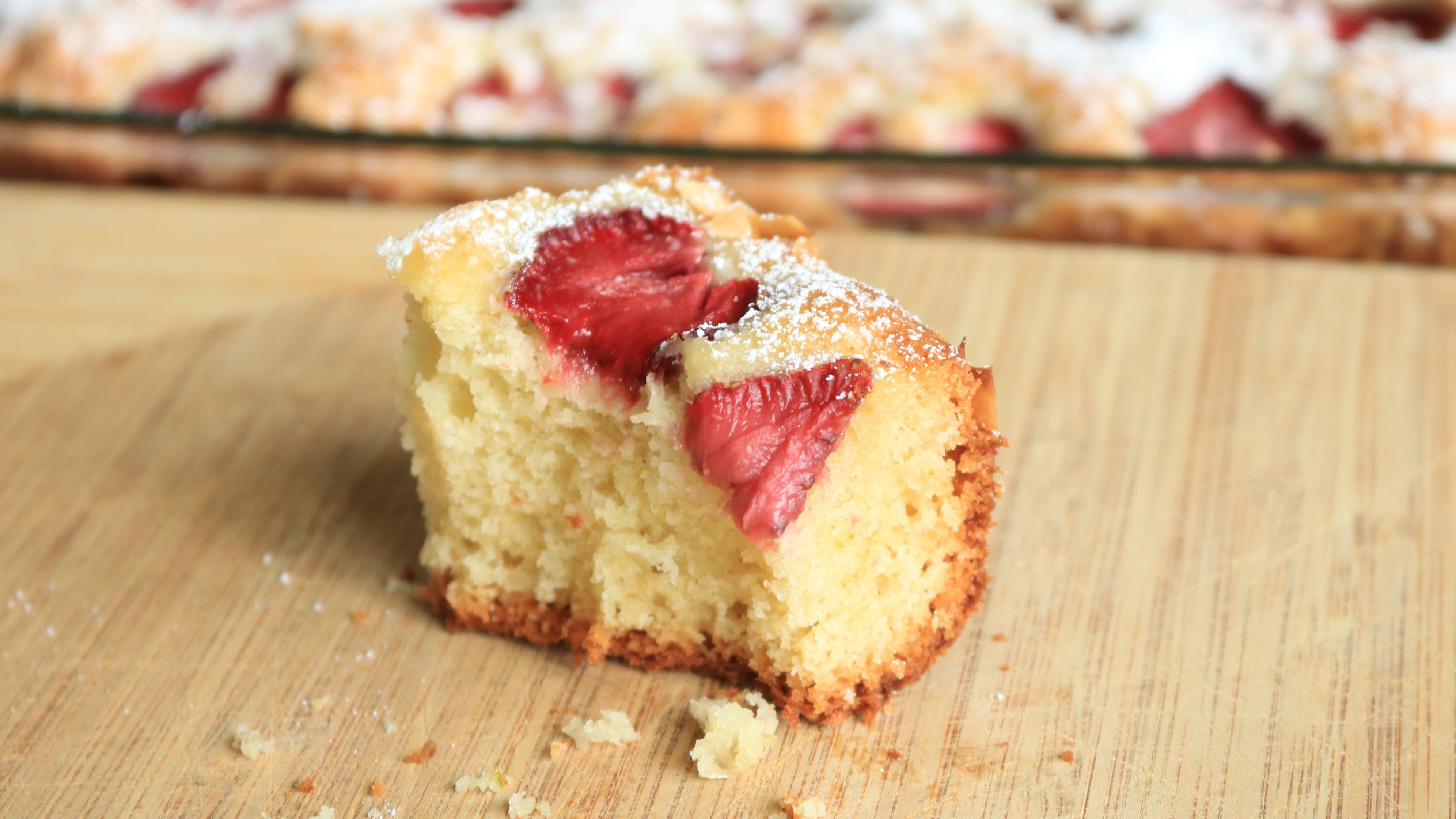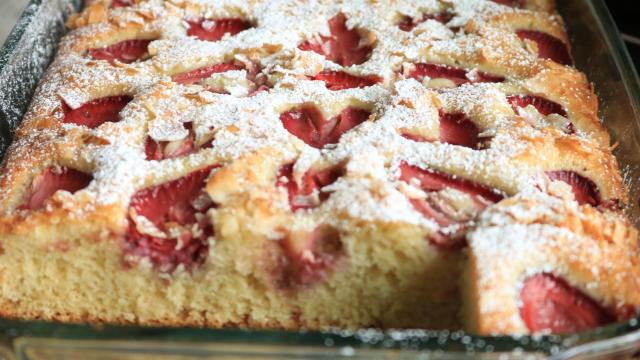The sheer variety of cake that exists in the world is thrilling, if a little overwhelming. Deciding between a butterfly-shaped cake with motors in it or a tower of bougie three-dollar cupcakes the size of a thumbnail can leave you questioning your life choices.
Luckily, there are cakes that keep things simple. Cakes that can feed a crowd and provide a delightful exclamation point to birthday parties, congratulatory celebrations, or the first day of summer. This occasion calls for a sheet cake! …But wait, which kind of sheet cake? The kind that stands up, the kind in a dish, or the type in a pan? Before you throw down your whisk and order 200 micro-cupcakes, here is some guidance on choosing the right sheet cake for your needs.
The snacking sheet cake
Also searchable as a “snacking cake,” this is the lower maintenance version of the two kinds of sheet cake. A snack cake, like this one from Taste of Home, is one layer of cake baked in a round or rectangular pan that gets a slather of frosting or icing, or is served plain. This method of making cakes has been around forever, and many home cooks casually call the rectangular variety a sheet cake. What makes this kind of cake alluring is the invitation to everyday indulgence; it’s meant to be enjoyed whenever you’d like a nosh. Ideal for nearly any casual situation, you can make a nine-inch square sheet cake for yourself on a Tuesday or an impressive full size sheet pan when you’re hosting a function with more than 40 guests. Most often this sheet cake is not so formal in presentation; at most it calls for an unceremonious swipe of frosting and is served by scooping a slice straight out of the pan.
To make a snacking sheet cake, first decide how many people you need to serve. An eight-inch square works well for nine or 10 people. To serve a crowd of around 20, you could make two pans of the former, or use a 9 x 13-inch baking dish. For parties of 25 or more, use a half sheet pan (or even go full sheet if your oven is big enough). Keep in mind that these cakes will be thinner due to the shorter rim.
Judging how much batter you need for bigger sheet cakes can get a little trickier. For 8-inch, 9-inch, or 9 x 13-inch sheet cakes, remember that a single box of cake mix would give you two 9-inch round layers. The recipe above for Taste of Home’s chocolate snack cake makes a little over 3 cups of batter and bakes into one 8-inch square layer. With that as your guide, about 6 cups will give you two separate cakes, but you’ll only need 4 ½-5 cups of batter for a 9 x 13 inch Pyrex. For even larger cakes, this chart from The Stay At Home Chef will steer you in the right direction, and using the two-thirds rule can help when filling the pans. But keep in mind, making a snack cake is supposed to be a laid-back affair; your cake can be thick or thin, so if your recipe comes up a little shy, don’t sweat it.
The layer cake
A multi-layer sheet cake is the more formal choice. Always rectangular and usually ordered from a bakery, this cake commonly comes in three sizes: quarter sheet, half sheet, or full sheet. Perhaps referring to this type of cake as a sheet cake is more popular in bakeries because they are always made in sheet pans and cut and assembled to the appropriate size from there. The benefit to these cakes is that you will always get a tall slice with two or three layers and frosting inside and out. These sheet cakes m are hulks of dessert, impressive in size, and provide a workable canvas for decorations and cake art galore.
This is the kind of cake you see with faces printed on them; the kind of cake that comes decorated with plastic toys. They are usually ordered for special occasions because they take hours to make, can involve numerous mixing bowls, require various specialty tools for decoration, and serve 15-20 people on up. Unlike the snacking cake, it would be highly unusual to make yourself a multi-layer sheet cake as a “Happy Tuesday,” but I’m totally here for it.
There are two avenues one can take to obtain a sheet cake. The simplest but more expensive route is to call or visit a bakery that makes them and let them guide you on choosing from the size, flavours, and decorations they offer. Again, this can run a fairly high price, depending on the time of year (graduation cakes are all the rage in May and June); you might have to place your order a month ahead of time.
The second way is to make the darn thing yourself. I’ll say this now, if you need a full sheet cake, you should order it. Unless you already have full sheet pans and an oven that can accommodate them, spending money on pans cuts into your budget. If that’s not a problem, pick a regular cake recipe and decide by how much you need to adjust it to get the appropriate amount of batter you need for the size of your pan (just like we did with the snacking cakes). Remember, you’ll need at least two layers of cake and enough frosting to fill and cover the entire thing.
When deciding on which sheet cake is the one for you, consider the occasion. Snack cakes are casual, more likely to be hand-held, everyday-is-a-day-for-cake kind of cake. They work well in hot weather because you can forgo buttercream frostings that melt and substitute a glaze, powdered sugar, or nothing at all. They’re also ideal for picnics, barbecues, and street parties because they stay in the dish they were baked in, making them easy for packing up and travelling without the risk of accidents. Layer cakes are a more formal way to serve a large number of people; they’re more substantial, and you can have multiple fillings and flavour combinations. They also provide the space for elaborate, show-stopping decorations to make a celebration really special. And, hey, if the party is big enough, you can always have both.
If you’re in the mood for a summery snack cake right now, try my Strawberry Coconut Lime Cake. The flavours are bright, tart, not too sweet, and, after a dusting of powdered sugar, it’s ready to slice and carry over to the couch. Although there’s no liquor in this cake (but I like where your head’s at), the lime zest adds a welcome margarita vibe to the flavour profile. Strawberries are in season at the moment, and this sheet cake uses plenty, but if you prefer a different fruit then by all means, slice it up and stick ‘em on.
Strawberry Coconut Lime Snack Cake

Ingredients:
- ¾ cup canola oil or other neutral oil
- 1 ½ cup sugar
- 2 eggs
- Zest and juice of 1 lime
- ½ cup greek yogurt
- ½ cup almond milk or other milk
- ½ teaspoon vanilla extract
- 2 ½ cups flour
- 2 teaspoons baking powder
- ¾ teaspoon baking soda
- ½ teaspoon salt
- ½ pound strawberries, sliced
- Coconut flakes for garnish (I use Bob’s Red Mill unsweetened coconut flakes.)
Preheat your oven to 180°C. Prepare a 13 x 9-inch baking dish by lightly buttering the inside and dusting it with flour.* Cut the strawberries in half, or in quarter inch slices, and set aside.
In a large bowl, whisk the oil, sugar and eggs until combined. Add the lime zest and juice, yogurt, almond milk, and vanilla extract. In a smaller bowl, combine the flour, baking powder, baking soda, and salt. Use a fork and lightly mix to distribute the leaveners and salt.
Add the dry mixture to the wet in three additions, whisking in each portion of the dry ingredients before adding the next. A few small lumps are ok.
Pour the batter into your prepared baking dish and smooth it out. Place the strawberry slices on the top. You can decoratively lay them or strew them across in any fashion, just try not to overload the top because they could sink to the bottom. Sprinkle coconut flakes across the top.
Bake at 180°C for 45-50 minutes. After 30 minutes, check to see if the coconut flakes are overbrowning. If they begin to, take a sheet of foil slightly longer than the length of the baking dish and tent it. Put the foil tent gently over the top of the dish. Try to avoid making contact with the centre of the cake. Leave it like this for the remainder of baking time.
Cool the snack cake completely. Slice and serve like this or with a dusting of powdered sugar.
*Note: You can line the dish with parchment, however, I don’t prefer that for a snack cake. It’ll be sliced, scooped, and served from the baking dish and that can lead to ripped parchment pieces stuck to slices and general weirdness.

Leave a Reply
You must be logged in to post a comment.